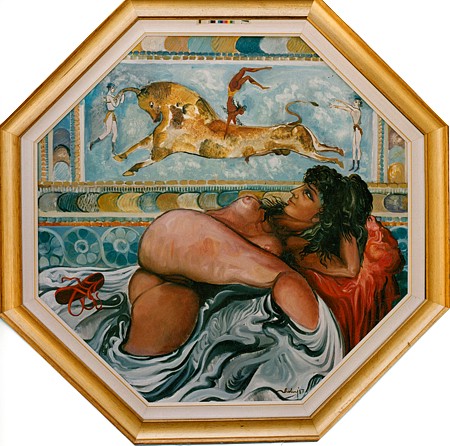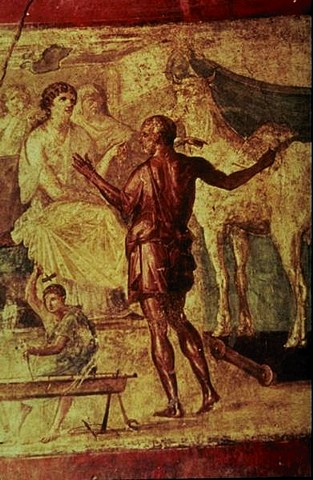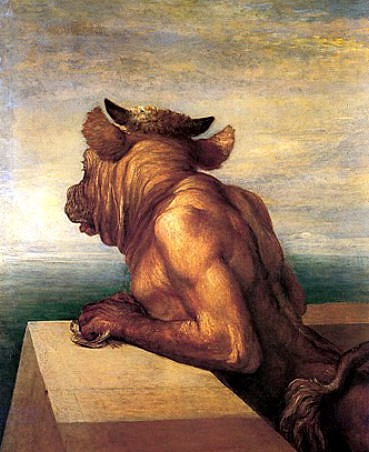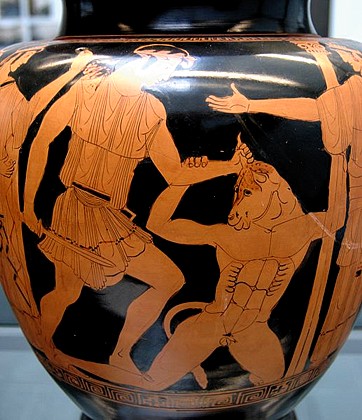Lessico
Pasifae

In greco Pasipháë,
in latino Pasiphaë. Sposa di Minosse![]() , il mitico re di
Creta
, il mitico re di
Creta![]() , è una
figlia del Sole
, è una
figlia del Sole![]() e pertanto sorella di Eeta, il re della Colchide
e pertanto sorella di Eeta, il re della Colchide![]() , e della
maga Circe
, e della
maga Circe![]() ; essa stessa passava per maga. Il mito di Pasifae si accentra sul
suo accoppiamento con un toro, dal quale genera il Minotauro, probabile
adombramento di un rito di “nozze” tra la regina e un toro sacro (sul tipo
delle “nozze” che in India accoppiavano simbolicamente la sposa del rajah
con un cavallo perché il rajah acquisisse una particolare potenza); oppure
espressione di un eventuale rito di ierogamia. Nella coscienza greca
l'episodio era considerato in senso negativo (come del resto tutta la realtà
cretese), compreso Minosse e il Minotauro; il toro era presentato come una
punizione del dio Poseidone e i desideri innaturali di Pasifae come una
maledizione della dea Afrodite
; essa stessa passava per maga. Il mito di Pasifae si accentra sul
suo accoppiamento con un toro, dal quale genera il Minotauro, probabile
adombramento di un rito di “nozze” tra la regina e un toro sacro (sul tipo
delle “nozze” che in India accoppiavano simbolicamente la sposa del rajah
con un cavallo perché il rajah acquisisse una particolare potenza); oppure
espressione di un eventuale rito di ierogamia. Nella coscienza greca
l'episodio era considerato in senso negativo (come del resto tutta la realtà
cretese), compreso Minosse e il Minotauro; il toro era presentato come una
punizione del dio Poseidone e i desideri innaturali di Pasifae come una
maledizione della dea Afrodite![]() .
.
Pasifae

Pasifae e Dedalo con la vacca di legno
Pittura murale della Casa dei Vettii – Pompei – I sec. dC
Pasifae è un personaggio della mitologia greca, figlia di Elio e di Perseide, una ninfa. È la madre del Minotauro. Moglie di Minosse, re di Creta, da lui ebbe otto figli, di cui Androgeo, Fedra e Arianna sono i più ricordati. Secondo la versione più comune del mito, Poseidone inviò a Minosse un bianchissimo toro affinché venisse sacrificato in suo nome. Il re di Creta però non obbedì al dio, ritenendo troppo bello quell'animale e ne sacrificò un altro: la vendetta di Poseidone non tardò ad arrivare. Infatti indusse in Pasifae una passione folle per l'animale e le fece desiderare ardentemente di congiungersi carnalmente con esso. Accecata dal desiderio, chiese aiuto a Dedalo, rifugiatosi a Creta per sfuggire a una condanna per omicidio, che le costruì una vacca di legno cava nella quale entrare per poter soddisfare la sua cieca voglia. Così Pasifae riuscì a congiungersi al toro, e dalla loro unione nacque il Minotauro.

Minotauro
- (1877-86)
George Frederick Watts (Londra 1817-1904)
Fu amata da Zeus, e da lui ebbe un figlio, Ammone. Talvolta questo figlio ha per madre Pasifae, ma un oracolo aveva predetto che sotto questo nome si celava un'altra donna, Cassandra, Dafne o anche una figlia di Atlante, che, attraverso Zeus, avrebbe concepito questa divinità.
A Pasifae era dedicato un culto oracolare in Laconia. Dante la ricorda nella Divina Commedia (Inferno XII, 13; Purgatorio XXVI, 41-42 e 86-87). Pasifae è anche il soggetto di un dipinto di Jackson Pollock, Pasiphaë (1943 circa).
In Greek mythology, Pasiphaë, "wide-shining", was the daughter of Helios, the Sun, by the eldest of the Oceanids, Perse. Like her doublet Europa, her origins were in the East, in her case at Colchis, the palace of the Sun; she was given in marriage to King Minos of Crete. With Minos, she was the mother of Ariadne, Androgeus, Glaucus, Deucalion, Phaedra, and Catreus. She was also the mother of "starlike" Asterion, called by the Greeks the Minotaur, after a curse from Poseidon caused her to experience lust for and mate with a white bull sent by Poseidon.

Theseus and the Minotaur
side A from an Attic red-figure stamnos ca. 460 BC
Staatliche Antikensammlungen
"The Bull was the old pre-Olympian Poseidon," Ruck and Staples remark. In the Greek literalistic understanding of a Minoan myth, in order to actually copulate with the bull, she had the Athenian artificer Daedalus construct a portable wooden cow with a cowhide covering, within which she was able to satisfy her unnatural desire. The effect of the Greek interpretation was to reduce a more-than-human female, daughter of the Sun itself, to a stereotyped emblem of grotesque bestiality and the shocking excesses of female sensuality and deceit. Pasiphaë appeared in Virgil's Eclogue VI (45-60), in Silenus' list of suitable mythological subjects, on which Virgil lingers in such detail that he gives the sixteen-line episode the weight of a brief inset myth. In Ovid's Ars Amatoria Pasiphaë is reduced to unflattering human terms: Pasiphae fieri gaudebat adultera tauri - "Pasiphaë took pleasure in becoming an adulteress with a bull."
In other aspects, Pasiphaë, like her niece Medea, was a mistress of magical herbal arts in the Greek imagination. The author of Bibliotheke (3.197-198) records the fidelity charm she placed upon Minos, who would ejaculate serpents and scorpions, killing any unlawful concubine; but Procris, with a protective herb, lay with Minos with impunity. In mainland Greece, Pasiphaë was worshipped as an oracular goddess at Thalamae, one of the original koine of Sparta. The geographer Pausanias describes the shrine as small, situated near a clear stream, and flanked by bronze statues of Helios and Pasiphaë. His account also equates Pasiphaë with Ino and the lunar goddess Selene.
Cicero writes in De Natura Deorum that the Spartan ephors would sleep at the shrine of Pasiphaë, seeking prophetic dreams to aid them in governance. According to Plutarch, Spartan society twice underwent major upheavals sparked by ephors' dreams at the shrine during the Hellenistic era. In one case, an ephor dreamed that some of his colleagues' chairs were removed from the agora, and that a voice called out "this is better for Sparta"; inspired by this, King Cleomenes acted to consolidate royal power. Again during the reign of King Agis, several ephors brought the people into revolt with oracles from Pasiphaë's shrine promising remission of debts and redistribution of land.